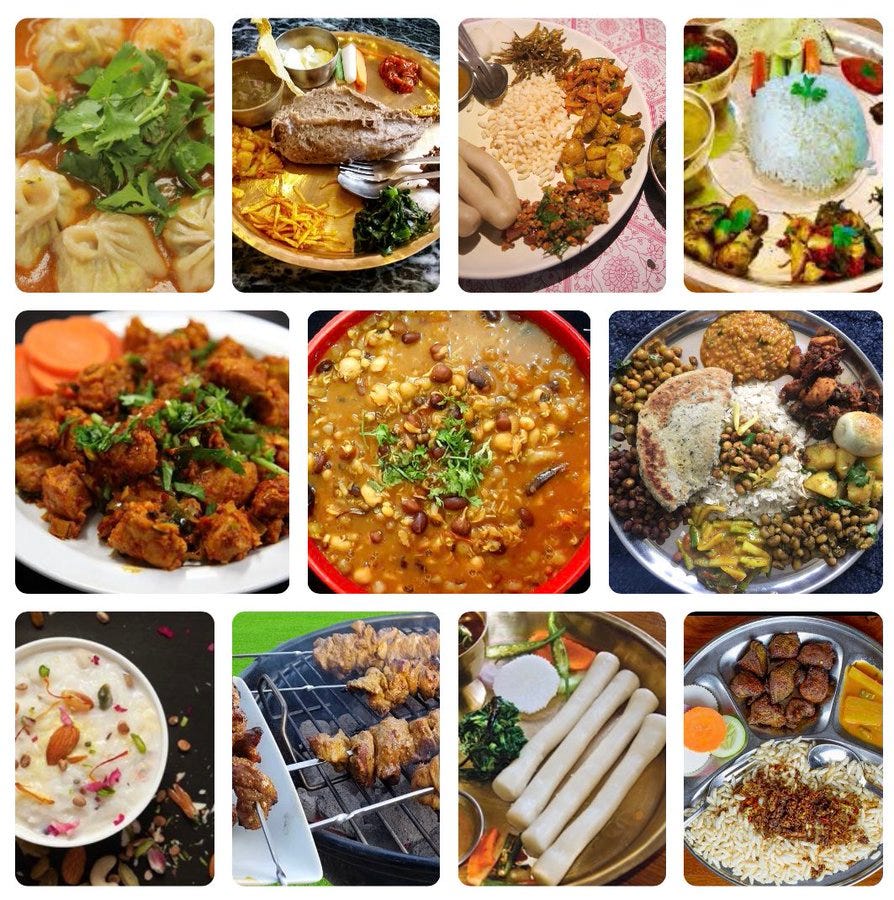How Nepali Cuisine uses Salt, Fat, Acid and Heat
Episode 2 – FAT (Subscribe for four more episodes, the next one is ACID)
Food represents Nepal's culture, tradition and practices based on geographical regions or ethnicity. Cooking is not all about food; it is a culture and tradition that brings together family, community, society and nation. In the globalized world and with internet connectivity, food is not limited to a particular geographical area and culture. It is beyond borders, and it is science, too. You can find "Dal Bhat" in the busy streets of Paris, "Momo" in Jackson Heights and "Choila" in the corners of London Street.
I started cooking in childhood, primarily to support my mother. Most of our favourite dishes come from our mother's recipe. Over time, I learned many cooking styles and experimented with fusion food from different cultures and traditions. While exploring culinary practices, as a science student, I decided to explore how the science of food influences Nepali cuisine.
Therefore, this article covers how salt, fat, acid, and heat influence Nepali cuisine and their linkages to culture and practices. The article is based on the book "Salt, Fat, Acid and Heat[1]" by Samin Nosrat. I want to share how these elements influence Nepali cuisines and food cultures. I will cite some examples from Nepali cuisines like Khas, Tibetan-influenced, Thakali, Newari, Limbu, Terai, or Tharu.
The article will have five sections. Each will cover salt, heat, acid, and fat, and the last one will explain how these elements make Nepal's two most famous dishes delicious. It’s time for FAT.
How Nepali Cuisine Uses FAT
Fat
Different types of oil and Ghee, including animal fat, are commonly used in Nepali cuisine. Fried foods from tareko/bhuteko potato to varieties of rotis (bread), fatty meat (three layers of meat, skin, fat and flesh is very popular for the taste buds of many Nepalese), and Ghee (used not only for rotis but traditionally pinch or small bowl of hot Ghee with rice or Dhedo is very common) are few examples how Nepali cuisines use fat to add flavour to their taste. The chapter covers the use of mustard oil and its uniqueness, which the world does not know.
Mustard oil, made using old-fashioned cold-pressing methods, has been an essential part of our kitchens. This traditional way of making it has supported small businesses for years and provided jobs to many while encouraging local buying and selling with low environmental impact. [2] Mustard oil has a strong, distinctive taste with sharp and slightly bitter notes. Its unique flavour pairs well with the spices and herbs typically used in pickles, creating a balanced taste that is hard to match with other oils. Roasted mustard oil, or 'bhuteko tori ko tel,' is another traditional variety made in mustard oil mills across the Kathmandu Valley. Unlike cold-pressed mustard oil, roasted oil is produced through a dry-roasting process, which mellows the raw mustard flavour and gives the oil a dark amber colour. [2] This type of oil is commonly used in dishes like choyela.
Mustard oil has many health benefits and has been used for centuries to help with colds, coughs, and breathing problems. [3] Inhaling steam with mustard oil can clear a stuffy nose, and massaging a mix of mustard oil, garlic, and ajwain on the feet and chest can ease cold and cough symptoms. The oil contains glucosinolates, which give it antibiotic, antifungal, and cancer-fighting properties. [4] It may help protect against colorectal and stomach cancers. Allyl isothiocyanate, found in mustard oil, works as an antifungal agent, helping to prevent fungal growth in food. Mustard oil also acts as a natural preservative for pickles, binding spices and dried fruits so they absorb the flavours. [5] The oil creates a protective layer, keeping out oxygen and preventing spoilage, which helps extend the pickle’s shelf life. Its low water content also stops the growth of bacteria and fungi, preserving the pickle's taste and quality.
In traditional Newari cuisine, quick-marinated dishes like cholera, kachina, and cha use mustard oil to balance the flavours of cumin, garlic, and ginger. [6] These dishes need no extra seasoning when the right mix of tanginess and spice is achieved with just salt and mustard oil. [6] The quality of each ingredient in pickle recipes with just a few ingredients is crucial. Using pure, high-quality mustard oil elevates the pickle's flavour and aroma. [2]
Mustard oil production in Nepal is more than just an industry; it reflects the country’s way of life, deeply tied to its agriculture, culture, and food traditions. [2] The importance of mustard oil in Nepali homes and its lasting place in the heart of Nepali cuisine cannot be overlooked. [2] It’s not just an ingredient but a cultural and culinary gem. Mustard oil enhances flavours, preserves pickles, offers health benefits and holds cultural meaning in many traditional dishes, especially in Nepal. [2] Its distinctive qualities make it vital for pickling, with a role that extends far beyond the kitchen.
Note: Adulterated mustard oil mixed with other oils can negatively impact the taste and aroma.
The next episode is 3 - ACID. The previous episode 1 - SALT
The images in the article are from Google Images, and I acknowledge all the photographers who have shared them.
[1] Samin Nosrat. (2017). Salt, Fat, Acid, Heat: Mastering the Elements of Good Cooking. Simon & Schuster.
[2] Binod Baral. (2023). The heritage of mustard oil in Nepali cuisine. The Annapurna Express.
[3] 9 Shravani Chintapali. Benefits of Mustard Oil (Plus how to use it). MedicineNet
[4] Pramita Uniyal. Ancient Wisdom Part 37: Mustard oil is a must in winter; benefits and best way to use it. The Hindustan Times
[5] Zhang Y. Allyl isothiocyanate as a cancer chemopreventive phytochemical. Mol Nutr Food Res. 2010 Jan;54(1):127-35. doi: 10.1002/mnfr.200900323. PMID: 19960458; PMCID: PMC2814364.
[6] Buff Choila Recipe: Favorite Newari Cuisine




